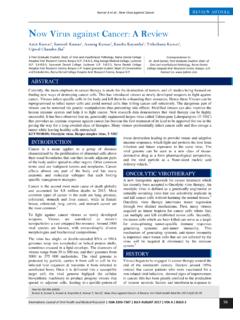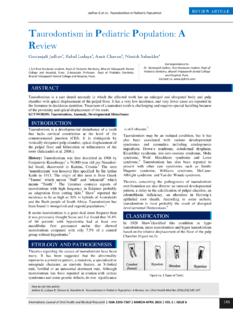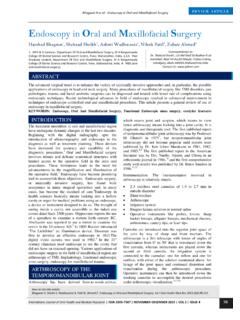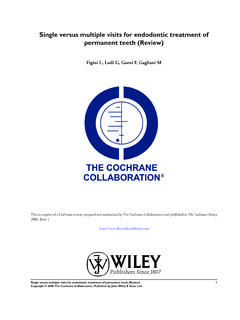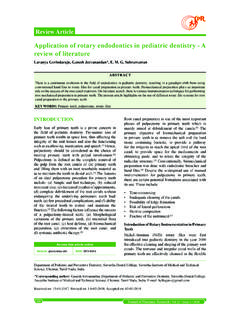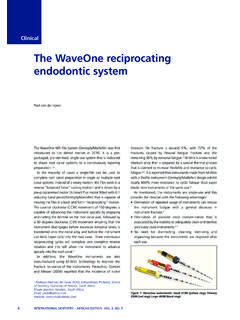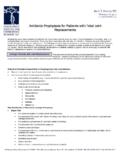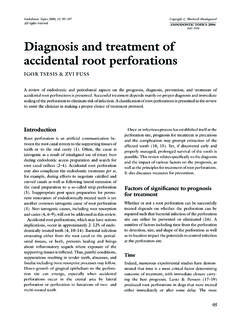Transcription of Endodontic Failures and its Management: A Review
1 International Journal of Oral Health and Medical Research | ISSN 2395-7387 | JANUARY-FEBRUARY 2016 | VOL 2 | ISSUE 5 144 Review ARTICLE Chaurasiya S et al.: Endodontic Failures and its management Correspondence to: Dr. Suman Chaurasiya, Student, Dept. Of Pedodontics & Preventive Dentistry, Sardar Patel Post Graduate Institute of Dental & Medical Sciences,Lucknow. Contact Us: Endodontic Failures and its management : A Review Suman Chaurasiya1, Gunjan Yadav2, Abhay Mani Tripathi3, Kavita Dhinsa4 The main goal of Endodontic treatment is the correct diagnosis, optimal mechanical and chemical preparation and three-dimensional obturation of the root canal. The causes of the Endodontic Failures can be variations in the anatomy of the teeth, the presence of additional root canals, lateral canals, depend on technical, biological and iatrogenic factors which contribute to accomplishment of treatment.
2 Knowing and understanding the relation between these factors may help in increasing the chances of preventing the possible Endodontic treatment Failures . KEYWORDS: Root canal treatment, Endodontic Failures , Root Canal Retreatment AA aaaasasa sss The general purpose of the Endodontic treatment is to maintain teeth duration as long as possible in the oral cavity. The main purpose of root canal treatment is to fill up or block all root canal and to form a fluid-tight seal on the apical foramen of the tooth, so that any possibility of a secondary infection occurrence due to the mouth cavity or periradicular tissue leakage into the root canal system can be The necessity for properly filling the canal seems obvious, once cleaning, shaping and disinfection are completed, yet ineffective obturation is often a prelude to eventual Endodontic For symptoms such as fistulation, swelling, pain, percussion, tenderness, discomfort during chewing and in cases in which the apical lesion becomes larger or is not diminishing retreatment is indicated.
3 The goals of nonsurgical retreatment are to remove materials from the root canal Even though Endodontic procedures have relatively high success rate compared with other disciplines, it is unwise to guarantee a perfect result even when procedures have been performed with the greatest of care. It is most important to understand the mechanisms of failure so that it can be recognized and dealt in an appropriate fashion. The causes of the Endodontic Failures have been classified into three phases:- I. Factors resulting in Failures prior to root canal treatment 1. Incorrect diagnosis 2. Technical difficulties 3. Vertical root fracture 4. Systemic diseases II. Factors resulting Failures during root canal treatment 1. Anatomical variations 2. Missed canal 3. Ledge formation 4. Infections 5. Poor debridement 6. Mechanical and chemical irritants 7.
4 Access preparation 8. Improper obturation 9. Overfillings of root canals 10. Furcation perforations III. Factors Resulting in Failures after Root Canal Treatment 1. failure following retreatment 2. failure following surgical retreatment IV. Miscellaneous 1. Nerve paresthesia 2. Tissue emphysema 3. Instruments aspiration and ingestion The most accurate determinations of healing and nonhealing are based on sign and symptoms, radiographic and histologic examinations. 7 Clinical Examination: Signs and/or symptoms, if marked and persistent, are probably indications of disease and Failures . Persistence of adverse significant signs ( , swelling or sinus tract) or symptoms ( , spontaneous pain, dull persistent ache or mastication sensitivity). How to cite this article: Chaurasiya S, Yadav G, Tripathi AM, Dhinsa K.
5 Endodontic Failures and its management : A Review . Int J Oral Health Med Res 2016;2(5):144-148. INTRODUCTION 1- Student, Dept. Of Pedodontics & Preventive Dentistry, Sardar Patel Post Graduate Institute of Dental & Medical Sciences,Lucknow. 2- Reader, Dept. Of Pedodontics & Preventive Dentistry, Sardar Patel Post Graduate Institute of Dental & Medical Sciences,Lucknow. 3 Head, Dept. Of Pedodontics & Preventive Dentistry, Sardar Patel Post Graduate Institute of Dental & Medical Sciences,Lucknow. 4- Sr. lecturer, Dept. Of Pedodontics & Preventive Dentistry, Sardar Patel Post Graduate Institute of Dental & Medical Sciences, Lucknow. ABSTRACT ETIO-PATHOGENESIS OF Endodontic failure DIAGNOSIS OF Endodontic failure International Journal of Oral Health and Medical Research | ISSN 2395-7387 | JANUARY-FEBRUARY 2016 | VOL 2 | ISSUE 5 145 Review ARTICLE Chaurasiya S et al.
6 : Endodontic Failures and its management indicates Endodontic Radiographic Findings: The importance of radiographic evaluation in determining Endodontic success or failure cannot be overemphasized. It is a universal tool in the assessment of treatment results without which no claim of success could be justified. Since the radiographic evaluation plays a basic role in the assessment of treatment results, any fallibility associated with the interpretation of radiograph directly distorts the reported rates of success and Histologic Examination: Routine histologic evaluation of periradicular tissues after root canal treatment is impractical and not possible without surgery. If treated tooth were to be evaluated histologically, successful treatment would be indicated by reconstitution of periradicular structures and an absence of The purpose of case selection is to determine the feasibility and practicality of treatment, so as to avoid treating cases that will fail regardless of the quality of Diagnosis: The presence or absence of periradicular disease is determined according to clinical and radiographic findings.
7 Differential diagnosis of non- Endodontic disease is also Selection of Treatment: Currently, the patient ultimately selects the treatment, based on information communicated by the Treatment of Existing Disease: Post-treatment disease definitely requires intervention, even when symptoms are absent. When treatment is preferred over extraction, re-treatment and apical surgery should be considered for both. Comparing the two modalities, retreatment offers a greater benefit and better ability to eliminate the disease's etiology (root canal infection) with minimal invasion and a smaller risk such as significantly less postoperative discomfort and a lesser chance of injuring nerves, sinuses or other structures. Therefore, case selection is based on patient, tooth and clinician considerations that either preclude retreatment or restrict its feasibility in a way that decreases the potential benefits and increases the potential risks; the modified benefit-risk balance may not outweigh that of apical 1.
8 Incorrect Diagnosis Incorrect oral examination leading to incorrect diagnosis is usually due to an interpretation of pain, vitality test and radiographs. Recognition-The wrong tooth has been treated is sometimes a result of re- evaluation of a patient who continues to have symptoms after Correction- Treating the wrong tooth includes appropriate treatment of both teeth ; the one tooth incorrectly opened and the one with the original pulpal 2. Missed Canal Some canals are not easily accessible or readily apparent from the Recognition- Missed canal occurs during or after treatment. During treatment, an instrument or filling material may be noticed to be other than exactly centered in the root, indicating that another canal is Correction- Retreatment is appropriate and should be attempted before recommending surgical 3.
9 Access cavity perforations One of the irreversible complications of endodontics is perforation into the furcation area while gaining access to pulp chamber of Recognition- If the access cavity perforation is above the periodontal attachment, the first sign of the presence of an accidental perforation will often be the presence of leakage: either saliva into the cavity or sodium hypochlorite out into the mouth, at which time the patient will notice the unpleasant taste. Correction- Several materials have been recommended for perforation repairs such as cavit, amalgam, calcium hydroxide paste, super ethoxy-benzoic acid (EBA), glass ionomer cement, gutta-percha, tricalcium phosphate or hemostatic agents such as gelfoam and mineral trioxide aggregate (MTA) which has shown convincing results in apical cavity 4.
10 Apical perforations Perforations in the apical segment of the root canal may be the result of file negotiating a curved canal or not establishing accurate working length and instrumenting beyond the apical confines. A paper point when inserted to the apex, will confirm a suspected apical Recognition- An apical perforation should be suspected if the patient suddenly complains of pain during treatment, if the tactile resistance of the confines of the canal space is lost. A paper point inserted to the apex will confirm a suspected apical Correction- Effort to repair apical perforations may be to attempt to renegotiate the apical canal segment or to consider the perforation site as the new apical opening and then decide what treatment the untreated apical root segment will 5. Crown Fractures The tooth may have a preexistent infarction that becomes a true fracture when the patient chews on the tooth weakened additionally by an access preparation.
